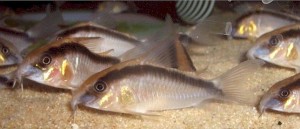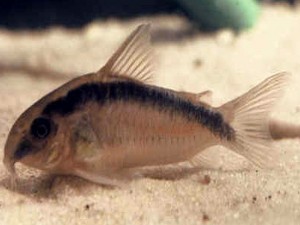Skunk Cory Cat (Corydoras arcuatus) is native to the Rio Unini, a whitewater area of the Rio Negro River in Brazil,generally considered to occur throughout the upper Amazon region in Brazil, Peru, Ecuador, and Colombia.
The Skunk Cory is also known by tropical fish keeping enthusiasts in the aquarium trade as the Arched Cory or Sands’ Cory Cat.
Whatever name you call them, the Corydoras arcuatus is a peaceful, interesting, active, shoaling species that prefers living among other Corys of their own size.
The Skunk Cory Cat is a popular community tank species that can be identified by the black stripe that runs over their eyes, down their back to just before the tail where it splits and trails down to color the lower edge of the caudal fin. In most other Cory species, the black stripe does not split but continues along the upper edge of the caudal fin. They have stiffened pectoral fin spines that are capable of piercing human skin and causing a painful “sting” from their mildly toxic secretions that are produced by the axillary glands at the base of each spine. Exercise care when handling these Corys.
Skunk Corys are peaceful bottom dweller that get along well with other like sized fish, especially when kept in small schools of 6 to 8 specimens. They are efficient cleaners of excess food from the aquarium substrate.
The Skunk or Sands’ Cory appreciates stronger water currents than other members of the Corydoras genus. They will thrive in a densely planted aquarium with a sandy substrate surrounded by Java Moss, Java Fern
and driftwood
areas for them to hide.
Like other Corydoras, this species will spawn eggs on either the aquariums glass, driftwood, or among the plants. Female Skunk Corys are noticeably wider and broader than males when viewed from above; especially when full of eggs.
Though this is one of the more difficult Corys to breed; breeding is similar to other Corys. The female carries a few eggs between her pelvic fins while the male fertilizes them. She then selects a safe spot to hide the eggs, usually near dense vegetation, and continues the process until all the eggs have been placed. Usually the female will lay around 100 eggs in several “safe” locations. After hatching, the fry should be removed from the tank and after 3 to 4 days fed a diet of until they are able to accept flake and frozen foods.
Feeding the pair a diet of live foods, keeping the pH at 6.5 to 7.0 and dropping the water temperature to 60 F. for water changes will usually induce spawning in this species.
Skunk Corys are omnivores and should be fed a mixed diet of good quality flake food, shrimp pellets, tubifex, and other freeze dried or frozen foods.
When available for purchase the Skunk Cory is usually 3/4″ to 1-1/4″ long.
Minimum Tank Size: 20 gallons
Care Level: Moderate
Temperament: Peaceful
Aquarium Hardiness: Hardy
Water Conditions: 68-77° F, KH 2-12, pH 6.2-7.2
Max. Size: 2½”
Color Form: Black, White
Diet: Omnivore
Compatibility: Great in community tanks
Origin: Brazil
Family: Callichthyidae
Lifespan: 3 – 5 Years or more
Aquarist Experience Lever: Beginner to Intermediate




